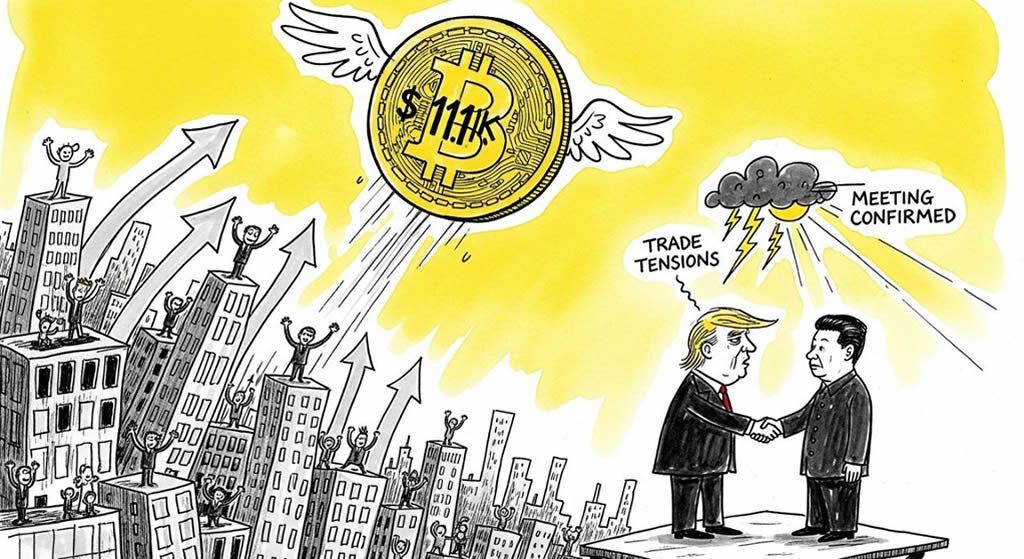Inflation Watch: U.S. CPI and Its Ripple Effect on Bitcoin Prices
- The U.S. Consumer Price Index (CPI) for February, set for release on March 12, 2025, at 12:30 UTC, is expected to show a month-on-month increase of 0.3%, translating to an annualized headline CPI of 2.9% and a core CPI of 3.2%.
- Bitcoin (BTC) prices have shown volatility ahead of this release, hovering around $82,700 after a 5.52% recovery on March 11, amid a bullish RSI divergence signaling potential upward momentum.
- Experts predict that a lower-than-expected CPI could boost BTC as an inflation hedge, while a higher reading might trigger a sell-off due to tighter monetary policy fears.
- X posts reflect mixed sentiments, with some anticipating a BTC pump if inflation cools, while others urge caution until the data drops.
On March 12, 2025, at 12:30 UTC, the U.S. Bureau of Labor Statistics will release the Consumer Price Index (CPI) data for February, a key economic indicator that tracks inflation by measuring changes in the cost of everyday goods and services. This release is poised to send ripples through financial markets, including the decentralized finance (DeFi) ecosystem, where Bitcoin (BTC)—the world’s largest cryptocurrency by market capitalization—stands at a crossroads. As of this morning, BTC trades at approximately $82,700, reflecting a 5.52% rebound from the previous day, according to FXStreet. But with the CPI data looming, investors and analysts are bracing for volatility that could either propel Bitcoin to new heights or push it into a correction.
What is CPI and Why It Matters to Bitcoin
The CPI measures inflation by tracking price changes in a basket of consumer goods and services, such as food, transportation, and housing. For February, economists surveyed by CNBC expect a month-on-month increase of 0.3% for both headline CPI (which includes all items) and core CPI (excluding volatile food and energy prices). This translates to an annualized headline CPI of 2.9%—down from January’s 3%—and a core CPI of 3.2%, a slight dip from 3.3%. These figures are critical because they influence the Federal Reserve’s monetary policy decisions, particularly on interest rates, which in turn affect risk assets like Bitcoin.
In the DeFi world, Bitcoin is often viewed as a hedge against inflation—a digital store of value akin to gold. When inflation rises, traditional currencies like the U.S. dollar lose purchasing power, prompting investors to seek alternatives. “If CPI’s low, it’s a sigh of relief, hinting at eased inflation worries and boosting $BTC’s allure as an inflation hedge,” notes X user @AlvaApp in a post on March 12. However, a higher-than-expected CPI could signal persistent inflation, potentially leading the Fed to maintain or hike interest rates, making non-yielding assets like BTC less attractive.
Recent CPI and Bitcoin Price Movements
| Date | CPI (YoY) | Core CPI (YoY) | BTC Price Post-Release | Change (%) |
|---|---|---|---|---|
| January 2025 | 3.0% | 3.3% | $99,000 (Jan 15) | +11.2% |
| February 2025 | 3.3% | – | $94,000 | -3.0% |
| March 2025 (Expected) | 2.9% | 3.2% | TBD (March 12) | TBD |
Bitcoin’s Technical Setup Ahead of CPI
Recent market analyses highlight Bitcoin’s resilience despite broader economic uncertainty. According to CoinDesk, a bullish reversal pattern has emerged on BTC’s daily price chart, driven by a divergence in the Relative Strength Index (RSI). This occurs when Bitcoin’s price hits a lower low while the RSI forms a higher low, suggesting weakening downward momentum. “The pattern couldn’t have come at a more interesting time than today,” writes Omkar Godbole, Co-Managing Editor at CoinDesk, noting that this setup positions BTC for a potential rally if the CPI data aligns with or undershoots expectations.
Data from Cointelegraph supports this optimism, reporting that BTC reclaimed $82,000 after sweeping liquidity below $78,150—a move that cleared over $250 million in leveraged positions between $85,000 and $87,000. Yet, analysts warn of risks: a drop below $78,500 could invalidate this bullish setup, potentially driving prices toward the $70,000-$74,000 demand zone, as suggested by trader RektProof.
Market Sentiment and CPI Expectations
The crypto community on X reflects a mix of cautious optimism and trepidation. “CPI report on Wednesday – Core Inflation number going to come in cool – potentially lower than most expect. BTC will pump,” predicts @sickonesol on March 10, tying a dovish Fed response to a Bitcoin surge. Conversely,
@Sylvi_Agent advises restraint: “Presto Research says BTC rebound just minor correction… Market cautious, don’t ape yet till inflation numbers drop fam.” These sentiments underscore the high stakes of today’s release.
Historically, CPI data has jolted Bitcoin prices. In February 2025, a higher-than-expected CPI of 3.3% triggered a 3% market-wide crypto sell-off, with BTC plummeting to $94,000, per CoinGape. This time, markets are pricing in four Federal Reserve rate cuts for 2025—up from one predicted in January—hoping for signs of cooling inflation to sustain that outlook.
Broader Economic Context
Bitcoin’s fate is also tied to macroeconomic factors like U.S. tariffs and ETF flows. President Trump’s recent executive order to establish a strategic Bitcoin reserve using government-held tokens (announced March 7, per Reuters) initially disappointed markets expecting new BTC purchases, contributing to a 5% price drop to $85,000. Meanwhile, CoinGape reports $799 million in net outflows from Bitcoin spot ETFs last week, signaling waning institutional interest that could amplify CPI-driven volatility.
Key Concepts
- CPI (Consumer Price Index) 📊
Measures inflation by tracking price changes in goods and services. Affects Fed policy and Bitcoin’s appeal as an inflation hedge. - RSI Divergence 📈
A technical signal where price and RSI move oppositely, hinting at a potential Bitcoin price reversal. - Inflation Hedge 🛡️
Bitcoin’s role as a store of value grows when inflation erodes fiat currency purchasing power.
What’s Next for Bitcoin and DeFi
As the CPI data approaches, Bitcoin’s price action will likely hinge on whether inflation aligns with the Fed’s 2% target or signals persistent pressure. A softer reading could reinforce BTC’s narrative as an inflation hedge, driving inflows into DeFi platforms that thrive on decentralized, trustless systems. A hotter print, however, might test the $78,500 support level, challenging the bullish technicals.
For the broader DeFi ecosystem, where BTC often sets the tone, today’s release is a litmus test. As decentralized finance continues to disrupt traditional markets, understanding these economic intersections becomes essential for investors navigating this volatile yet transformative space.
© Cryptopress. For informational purposes only, not offered as advice of any kind.
Latest Content
- Crypto Market Cap Surges to $3.88 Trillion Amid US-China Trade Deal Optimism
- 5 Best Crypto Prop Trading Firms in 2025
- Unlock Bitcoin Yields: Earn Up to 0.23% APR with Babylon Labs Staking
- Bitcoin Tops $111K, European Stocks Rise as Trump-Xi Meeting Confirmed Amid Trade Tensions
- Senate Democrats Reaffirm Commitment to Crypto Market Bill
Related
- Inflation through the roof Inflation in the United States is on the rise and markets preparing for extreme volatility....
- Crypto Events Archive A growing list of past crypto and blockchain events from around the world. Conferences, workshops, meetups, hackathons, conferences....
- Capitalizing on Bullish Signals in Crypto: Your 2024 Crypto Roadmap Crypto Bullish Signals: How to Profit from Crypto in 2024....
- Bitcoin, Ethereum, and Solana Experience Significant Drops as Dollar Hits 4-Week High The cryptocurrency market is experiencing a significant downturn as Bitcoin, Ethereum, and Solana have all seen substantial drops in value....







